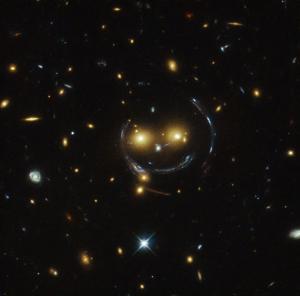Artist Creates Blog That Covers The Art Of Recognizing Resemblances

February 9th, 2015 - Austin, tx
The best part of the art of Recognizing Resemblances and then Extracting them, is the fact that it is one of the few art forms regularly covered by news agencies the world over. This blog will be covering the latest Resemblances covered by the news as well as those Extracted by artist Ismael Cavazos, creator of the Old Man in the Peanut.
Here is a sample of the latest:
Our latest Resemblance has popped up in the skies above. I have created this text-based emoticon to mimic what galaxy cluster SDSS J1038+4849 seems to be illustrating (° ͜・ ° )
So far, it is being covered by
news.com.au
http://www.news.com.au/technology/science/hubble-space-telescope-captures-a-happy-face-looking-over-earth/story-fnjwlcze-1227213886422
Washing Post
http://www.washingtonpost.com/news/speaking-of-science/wp/2015/02/09/the-hubble-spotted-this-smiley-face-in-space/
Headlines & Global News
http://www.hngn.com/articles/67727/20150209/hubble-space-telescope-snaps-picture-smiling-galaxy-photo.htm
Time
http://time.com/3701271/hubble-telescope-smiley-face/
China Topix
http://www.chinatopix.com/articles/36439/20150209/sdss-j1038-4849-smiling-galaxy.htm
According to the Hubble Telescope website: "You can make out its two orange eyes and white button nose. In the case of this “happy face”, the two eyes are very bright galaxies and the misleading smile lines are actually arcs caused by an effect known as strong gravitational lensing.
Galaxy clusters are the most massive structures in the Universe and exert such a powerful gravitational pull that they warp the spacetime around them and act as cosmic lenses which can magnify, distort and bend the light behind them. This phenomenon, crucial to many of Hubble’s discoveries, can be explained by Einstein’s theory of general relativity.
In this special case of gravitational lensing, a ring — known as an Einstein Ring — is produced from this bending of light, a consequence of the exact and symmetrical alignment of the source, lens and observer and resulting in the ring-like structure we see here."

